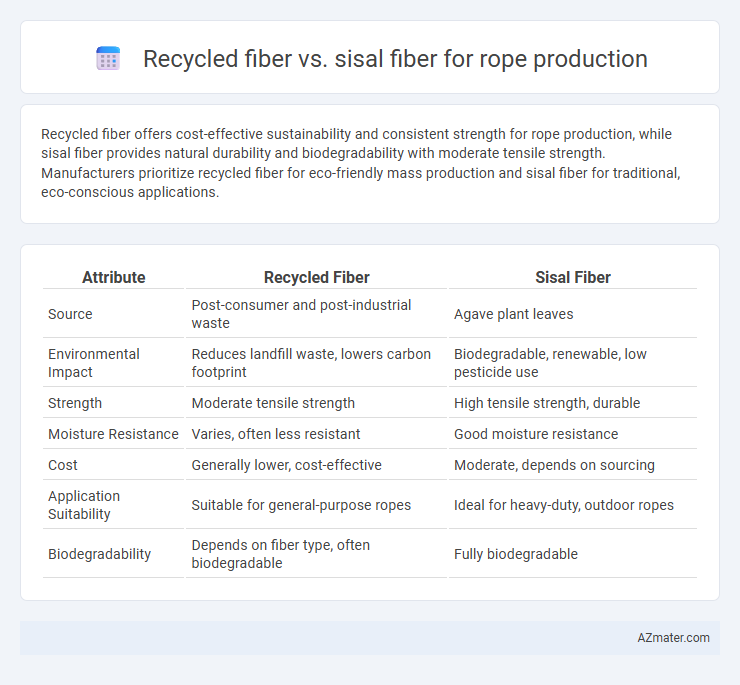Recycled fiber offers cost-effective sustainability and consistent strength for rope production, while sisal fiber provides natural durability and biodegradability with moderate tensile strength. Manufacturers prioritize recycled fiber for eco-friendly mass production and sisal fiber for traditional, eco-conscious applications.
Table of Comparison
| Attribute | Recycled Fiber | Sisal Fiber |
|---|---|---|
| Source | Post-consumer and post-industrial waste | Agave plant leaves |
| Environmental Impact | Reduces landfill waste, lowers carbon footprint | Biodegradable, renewable, low pesticide use |
| Strength | Moderate tensile strength | High tensile strength, durable |
| Moisture Resistance | Varies, often less resistant | Good moisture resistance |
| Cost | Generally lower, cost-effective | Moderate, depends on sourcing |
| Application Suitability | Suitable for general-purpose ropes | Ideal for heavy-duty, outdoor ropes |
| Biodegradability | Depends on fiber type, often biodegradable | Fully biodegradable |
Introduction to Rope Fiber Materials
Recycled fiber and sisal fiber represent two distinct materials used in rope production, each offering unique benefits. Recycled fibers, often derived from post-consumer textiles or industrial waste, contribute to sustainability by reducing environmental impact and resource consumption. Sisal fiber, a natural vegetable fiber extracted from the leaves of the Agave sisalana plant, is highly valued for its strength, durability, and biodegradability in traditional rope manufacturing.
Overview of Recycled Fiber
Recycled fiber for rope production primarily involves repurposing materials such as recycled polyester, nylon, and cotton, offering significant environmental benefits by reducing waste and lowering the carbon footprint compared to virgin fibers. These fibers provide high tensile strength and durability, making them suitable for various rope applications including marine, industrial, and agricultural uses. The use of recycled fibers aligns with sustainable manufacturing practices, promoting circular economy principles in the rope industry.
Overview of Sisal Fiber
Sisal fiber, derived from the Agave sisalana plant, is a natural, biodegradable fiber commonly used in rope production due to its strength, durability, and resistance to moisture. Compared to recycled fiber, sisal offers superior tensile strength and natural resistance to abrasion, making it ideal for heavy-duty ropes in marine and agricultural applications. Its eco-friendly characteristics and renewable sourcing position sisal fiber as a sustainable alternative to synthetic and recycled fibers in the rope manufacturing industry.
Environmental Impact Comparison
Recycled fiber ropes significantly reduce landfill waste and lower carbon emissions by reusing existing materials, making them a more sustainable choice compared to sisal fiber ropes. Sisal fiber, derived from the Agave sisalana plant, is biodegradable and renewable but involves intensive water and pesticide use during cultivation, increasing its environmental footprint. Lifecycle assessments indicate recycled fiber ropes generally have a smaller environmental impact due to resource conservation and reduced reliance on agricultural inputs.
Mechanical Properties and Strength
Recycled fibers used in rope production often exhibit variable tensile strength and lower mechanical consistency due to fiber degradation and contamination, while sisal fiber provides superior tensile strength and durability with natural resistance to abrasion and UV damage. Sisal ropes typically demonstrate higher modulus of elasticity and tensile load capacity, making them ideal for heavy-duty applications requiring long-term performance. The natural lignin and cellulose content in sisal fibers contribute to enhanced mechanical stability compared to the heterogeneous composition of recycled fibers.
Durability and Longevity
Recycled fiber ropes offer moderate durability but tend to degrade faster under prolonged exposure to moisture and UV light compared to sisal fiber ropes. Sisal fiber, derived from the Agave plant, is inherently strong, resistant to abrasion, and provides superior longevity in outdoor and marine environments. The natural toughness and rot-resistant properties of sisal make it a preferred choice for applications requiring long-term durability.
Cost Effectiveness and Market Availability
Recycled fiber offers superior cost effectiveness in rope production due to lower raw material expenses and reduced processing costs compared to sisal fiber. Sisal fiber, while durable and naturally strong, faces limited market availability and higher price fluctuations owing to agricultural dependency and seasonal variations. The widespread availability and affordability of recycled fibers from industrial waste streams make them a more economically viable option for large-scale rope manufacturing.
Applications in Rope Production
Recycled fiber in rope production offers environmental benefits and cost efficiency, making it suitable for general-purpose ropes used in packaging, agriculture, and marine applications. Sisal fiber provides superior strength, durability, and natural resistance to saltwater, ideal for heavy-duty ropes employed in maritime, construction, and outdoor environments. The choice between recycled and sisal fibers depends on application-specific requirements such as tensile strength, abrasion resistance, and environmental impact.
Maintenance and Performance in Use
Recycled fiber ropes offer superior durability and require minimal maintenance due to their resistance to environmental factors like moisture and UV exposure. Sisal fiber ropes, while biodegradable and eco-friendly, tend to degrade faster with frequent use, demanding regular inspection and maintenance to prevent fraying and weakening. Performance-wise, recycled fiber provides enhanced strength and longevity, making it ideal for heavy-duty applications, whereas sisal fiber excels in light to medium tasks where biodegradability is prioritized.
Future Trends and Innovations
Recycled fiber rope production is gaining momentum due to its environmental benefits, with innovations focusing on enhancing fiber strength and durability through advanced chemical treatments and bio-based coatings. Sisal fiber, valued for its natural biodegradability and tensile strength, is being improved via genetic modification and sustainable cultivation practices to increase yield and fiber quality. Emerging trends in rope manufacturing prioritize hybrid fibers combining recycled and sisal materials to optimize performance, reduce carbon footprint, and meet growing demand in marine, agricultural, and industrial sectors.

Infographic: Recycled fiber vs Sisal fiber for Rope production
 azmater.com
azmater.com